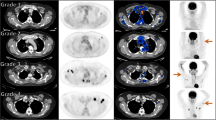Abstract
Background
The vaccination immune response may induce false-positive 18F-FDG PET/CT uptake.
Case presentation
An extended supraclavicular lymph nodal activation after coronavirus disease 2019 (COVID-19) vaccination revealed on 18F-FDG PET/CT mimics a Virchow nodule in a patient with medical history of well-differentiated appendicular adenocarcinoma.
Conclusion
This case highlights a nodal activation beyond axillary area and the importance of documenting vaccination history at the time of scanning to avoid false-positive results.
Similar content being viewed by others
Background
Development of vaccines to prevent COVID-19 is a hope to prevent transmission or reduce the severity of infection. However, vaccination could be a potential source of false-positive results in 18F-FDG PET/CT (Katal et al. 2021).
Case presentation
We present the case of a 64-year-old female with well-differentiated appendicular adenocarcinoma associated with peritoneal carcinosis initially treated by surgery and chemotherapy benefited from a 18F-FDG PET/CT to investigate a peritoneal nodule (Fig. 1). This peritoneal nodule (arrow) visualized on the axial (a) view of CT image showed no increased FDG uptake on the axial (b) PET/CT fused image. The MIP (c) and axial (D) PET/CT fused images detected an intense hypermetabolism on the left axillary lymph nodes up to the left supraclavicular area. The patient revealed she had received the first of dose Pfizer BNT162b2mRNA vaccine against COVID-19 on the left shoulder intramuscular 4 days before FDG examination. In order to exclude a Virchow nodule due to her digestive cancer history, we performed a cervical echography with supraclavicular node cytological biopsy sample. Echography (E) showed a 14-mm-long axis normal lymph node with its central hilum. Cytological analysis revealed activated lymphoid cells without tumor cells.
CT scan showed a peritoneal nodule (arrow in a) with no increased uptake on fused 18F-FDG PET/CT images (arrow in b). MIP (c) and fused 18F-FDG PET/CT (d) showed with increased uptake on the left axillary lymph nodes up to the left supraclavicular area. Echography (e) showed a normal supraclavicular lymph node
Discussion
Several previous reports have demonstrated axillary lymph nodal activation on 18F-FDG PET/CT following influenza and COVID-19 vaccination (Burger et al. 2011; Shirone et al. 2012; Eifer et al. 2021; Nawwar et al. 2021). This case revealed an atypical extended supraclavicular activation. In the context of the COVID-19 pandemic and large vaccination programs, questionnaires including date and location of the vaccination can help to avoid false-positive lymph node interpretation with the risk of a therapeutic choice impact offered to the patient. In patients with solid tumor like breast cancer or melanoma, the vaccination should be performed in the contralateral arm to limit misinterpretations. Otherwise, it would be advisable to respect a time interval to define between the vaccination and 18F-FDG PET/CT scan.
Conclusion
Nuclear physicians should be careful when cancers staging and re-staging. This is especially important for patients with breast cancer having been vaccinated on the homolateral upper limb, digestive cancer patients vaccinated on the left side, or with lung or head and neck carcinoma.
Availability of data and materials
Not applicable
References
Burger IA, Husmann L, Hany TF, Schmid DT, Schaefer NG (2011) Incidence and intensity of F-18 FDG uptake after vaccination with H1N1 vaccine. Clin Nucl Med. 36(10):848–853. https://doi.org/10.1097/RLU.0b013e3182177322
Eifer M, Eshet Y (2021) Imaging of COVID-19 vaccination at FDG PET/CT. Radiology. 28:210030
Katal S, Pouraryan A, Gholamrezanezhad A (2021) COVID-19 vaccine is here: practical considerations for clinical imaging applications. Clin Imaging. 76:38–41. https://doi.org/10.1016/j.clinimag.2021.01.023
Nawwar AA, Searle J, Hagan I, Lyburn ID (2021) COVID-19 vaccination induced axillary nodal uptake on [18F]FDG PET/CT. Eur J Nucl Med Mol Imaging. 26:1–2
Shirone N, Shinkai T, Yamane T, Uto F, Yoshimura H, Tamai H, Imai T, Inoue M, Kitano S, Kichikawa K, Hasegawa M (2012 Apr) Axillary lymph node accumulation on FDG-PET/CT after influenza vaccination. Ann Nucl Med. 26(3):248–252. https://doi.org/10.1007/s12149-011-0568-x
Acknowledgements
Not applicable
Funding
No funding
Author information
Authors and Affiliations
Contributions
Conception and design: VF; BM; DR; FD; CR. Acquisition of data, analysis and interpretation of data: VF; BM; DR; FD; CR. Drafting the article and final approval of the revised manuscript: VF; BM; DR; FD; CR. All authors read and approved the final manuscript.
Corresponding author
Ethics declarations
Ethics approval and consent to participate
As the FDG-PET/CT was part of a routinely performed clinical examination, no ethics approval was needed.
Consent for publication
For this case report, the patient has consented to the submission.
Competing interests
The authors declare that they have no conflicts of interest or competing interests.
Additional information
Publisher’s Note
Springer Nature remains neutral with regard to jurisdictional claims in published maps and institutional affiliations.
Rights and permissions
Open Access This article is licensed under a Creative Commons Attribution 4.0 International License, which permits use, sharing, adaptation, distribution and reproduction in any medium or format, as long as you give appropriate credit to the original author(s) and the source, provide a link to the Creative Commons licence, and indicate if changes were made. The images or other third party material in this article are included in the article's Creative Commons licence, unless indicated otherwise in a credit line to the material. If material is not included in the article's Creative Commons licence and your intended use is not permitted by statutory regulation or exceeds the permitted use, you will need to obtain permission directly from the copyright holder. To view a copy of this licence, visit http://creativecommons.org/licenses/by/4.0/.
About this article
Cite this article
Fleury, V., Maucherat, B., Rusu, D. et al. COVID-19 vaccination may cause FDG uptake beyond axillary area. European J Hybrid Imaging 5, 11 (2021). https://doi.org/10.1186/s41824-021-00105-2
Received:
Accepted:
Published:
DOI: https://doi.org/10.1186/s41824-021-00105-2





